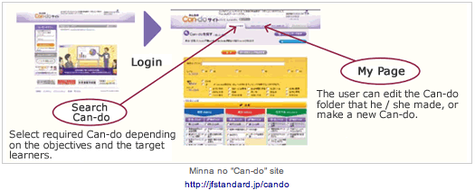Activity Reports:Japanese-Language Education Overseas:"JF STANDARD FOR JAPANESE-LANGUAGE EDUCATION 2010" Is Released
Research and Development Section,
The Japan Foundation Japanese-language Institute, Urawa
Since its establishment in 1972, the Japan Foundation (hereafter referred to as "JF") has been promoting Japanese-language education overseas. As the demands and methods for Japanese-language education become diversified, JF has been engaged in the development of "JF STANDARD FOR JAPANESE-LANGUAGE EDUCATION" (hereafter referred to as "JF Standard") since 2005, and "JF STANDARD FOR JAPANESE-LANGUAGE EDUCATION 2010" was released in March 2010.
The JF believes two competences are required in order to achieve mutual understanding through Japanese around the world competence in accomplishing tasks, which involves what a person can do by using Japanese, and competence in intercultural understanding, which involves understanding and respecting other cultures by expanding one's horizon through encounters with various cultures.
In order to realize "Japanese for mutual understanding," JF has been developing "JF Standard" as a tool to help think about teaching, learning, and assessment in Japanese-language education. "JF STANDARD FOR JAPANESE-LANGUAGE EDUCATION 2010" illustrates the proficiency in Japanese by using a set of sentences that describe what the learner "can do" in Japanese, which are based on the language proficiency levels specified by CEFR*, and provides them on the website "Minna no 'Can-do' Website".
* CEFR···(Common European Framework of Reference for Languages: Learning, teaching, assessment)
By providing the same framework to describe language proficiency for various Japanese-language classrooms, learners and teachers of the Japanese language around the world can see at what level they are learning or teaching, wherever they are in the world.
For more information on "JF STANDARD FOR JAPANESE-LANGUAGE EDUCATION 2010", please visit the following website:
Here you can see information on "JF STANDARD FOR JAPANESE-LANGUAGE EDUCATION".
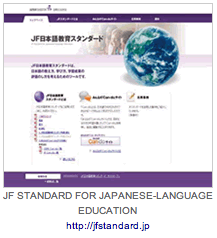 From this website, you can download the PDF version of "JF STANDARD FOR JAPANESE-LANGUAGE EDUCATION 2010" and "JF STANDARD FOR JAPANESE-LANGUAGE EDUCATION 2010 User's Guide" (free of charge). The former Is an overview of JF Standard, which also includes a brief instruction on how to use it. The latter explains how to use JF Standard in more detail, and is intended for Japanese-language teachers.
From this website, you can download the PDF version of "JF STANDARD FOR JAPANESE-LANGUAGE EDUCATION 2010" and "JF STANDARD FOR JAPANESE-LANGUAGE EDUCATION 2010 User's Guide" (free of charge). The former Is an overview of JF Standard, which also includes a brief instruction on how to use it. The latter explains how to use JF Standard in more detail, and is intended for Japanese-language teachers.
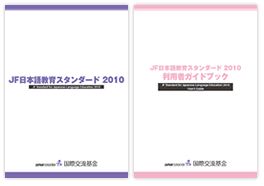 This new "JF STANDARD FOR JAPANESE-LANGUAGE EDUCATION 2010" describes three essential points for "Japanese for mutual understanding: "1: "JF Standard Tree", 2: "Can-do"; and 3: "Portfolio".
This new "JF STANDARD FOR JAPANESE-LANGUAGE EDUCATION 2010" describes three essential points for "Japanese for mutual understanding: "1: "JF Standard Tree", 2: "Can-do"; and 3: "Portfolio".
"JF STANDARD FOR JAPANESE-LANGUAGE EDUCATION 2010" supports classroom practices using "Can-do", such as course design, lesson planning, and teaching material development.
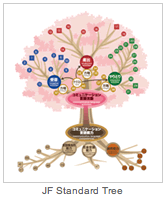 1. "JF Standard Tree" depicts the relationship between communicative language activities and communicative language competences as a tree. It is useful for finding out what the learners can or want to do using Japanese and what kind of language competences ( lexical, grammatical, sociolinguistic, etc.) are required.
1. "JF Standard Tree" depicts the relationship between communicative language activities and communicative language competences as a tree. It is useful for finding out what the learners can or want to do using Japanese and what kind of language competences ( lexical, grammatical, sociolinguistic, etc.) are required.
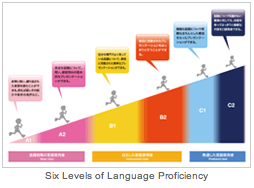 2. Can-do is a set of sentences that describe what the learner "can do" in Japanese, using CEFR's six levels of language proficiency. The six levels are divided into "Basic User" (A1 and A2), "Independent User"(B1 and B2) and "Proficient User"(C1 and C2). It is useful for thinking about Japanese learning in terms of what the learner can do by using what they have learned, instead of how much grammar or how many Japanese words and kanji characters the learner knows. In the database of "Can-do" called Minna no Can-do Website (which will be explained below), users can search for "Can-do" by different language activities or by proficiency levels.
2. Can-do is a set of sentences that describe what the learner "can do" in Japanese, using CEFR's six levels of language proficiency. The six levels are divided into "Basic User" (A1 and A2), "Independent User"(B1 and B2) and "Proficient User"(C1 and C2). It is useful for thinking about Japanese learning in terms of what the learner can do by using what they have learned, instead of how much grammar or how many Japanese words and kanji characters the learner knows. In the database of "Can-do" called Minna no Can-do Website (which will be explained below), users can search for "Can-do" by different language activities or by proficiency levels.
3. Portfolio is a tool to record and preserve each learner's learning process. Also, by assessing achievements and reflecting on the records of their linguistic and cultural experiences, the learners' competences in accomplishing tasks and intercultural understanding can be nurtured. If learners move to different places for going to colleges, studying abroad, or employment, they can communicate what they have achieved and their proficiency accurately.
Minna no "Can-do" Website
As explained above in 2, this is a database of "Can-do" sentences that describes what and how well the learner can do in Japanese. It supports the classroom practices using "Can-do", such as course design, lesson planning, and teaching material development. User registration is required, but the user can log into the website with the ID and password for "Minna no Kyozai" Website.
As of May 2010, all 493 CEFR Can-do for six levels, and 173 JF Can-do for two levels (A2 and B1), the latter of which the JF created based on the CEFR, are in the database. JF Can-do for A1 and B2 levels will be added by the end of FY 2010.
By using feedback from the users, the JF will enrich the "Minna no "Can-do" Website", develop teaching materials, collect examples of educational practices based on JF Standard, and enhance the contents of JF Standard itself
Related Articles
Back Issues
- 2025.9.30 The 51st Japan Found…
- 2025.9.30 The Japan Foundation…
- 2025.9.30 Bringing the World C…
- 2025.9.30 The 51st (2024) Japa…
- 2025.9.30 Japan Foundation Pri…
- 2024.5.24 The 50th Japan Found…
- 2024.3. 4 Movie Theaters aroun…
- 2023.4.10 The 49th Japan Found…
- 2023.3.28 JF's Initiatives for…
- 2023.1.27 Living Together with…


